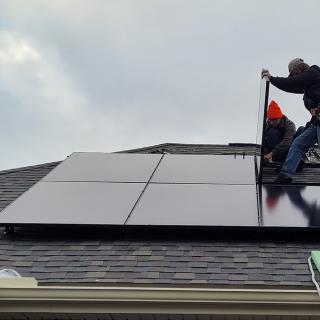Advertisement
US Energy Storage Sets New Record
The U.S. energy storage market set a record for quarterly growth in the second quarter of 2025, with 5.6 GW of installations, according to the latest U.S. Energy Storage Monitor report released today by the American Clean Power Association (ACP) and Wood Mackenzie.
The utility-scale market led the way, setting a record with 4.9 GW installed, enough capacity to power 3.7 million American homes during average peak load demand.
The residential storage market expanded 608 M. This represents a 132 percent increase year-over-year and an 8 percent jump quarter-over-quarter.
- Most of the growth was driven by California, Arizona and Illinois,
Residential storage is expected to outpace solar due to stronger policy resilience, high attachment rates in key markets and continued investment tax credit access through third-party ownership."
Wood Mackenzie projects that these record levels of additional storage capacity will continue into the foreseeable future.
Renewable Energy Jobs grew 3X faster in 2024
Renewable energy jobs grew more than three times faster than the rest of the U.S. economy in 2024. However, future growth could be in jeopardy, according to the 10th annual Clean Jobs America report released by E2.
The report showed that the renewable energy sector added almost 100,000 new jobs, bringing the total number of renewable energy workers in the United States to 3.56 million. However, policy uncertainty and an overall slowing of job and economic growth in 2024 led to the growth in renewable energy jobs dropping to its slowest pace since 2020, adding about 50,000 fewer jobs than in 2023.
More than 7 percent of all new jobs added in the United States and 82 percent of all new energy jobs added last year were in renewable energy occupations.
According to E2, since January 2025, companies canceled more than $22 billion planned clean energy related factories and other projects that were expected to create 16,500 new jobs. Analysis by other organizations estimate more than 830,000 jobs could be lost just because of the energy policy rollbacks in President Trump's One Big Beautiful Bill Act, signed into law on July 4.
These federal policy assaults come even as the U.S. Bureau of Labor Statistics reported that the fastest-growing occupations in America are wind turbine service technicians and solar photovoltaic installers.
Global Solar Installations surge 64 percent so far in 2025
While the US is facing increased policy headwinds to the expansion of solar, the rest of the world is setting new capacity records.
China led the pack in solar installations, adding 256 GW so far this year– more than twice as much (67 percent) solar capacity as the rest of the world combined.
India came in second behind China, installing 24 GW, while the U.S. placed third, installing about 21 GWWorldwide, 380 GW of new solar capacity was installed in the first half of this year, marking a 64 percent increase from 2024, when 232 GW was installed in the same timeframe, according to a report from the clean energy think tank Ember.
"In 2024, global solar output rose by 28 percent (+469 TWh) compared to 2023.
Fracking's Broken Promise
In 2013, when the Appalachian fracking rush was still in its early days, then President Barack Obama extolled its benefits in his State of the Union address. Along with the economic benefits of extraction and insulating the nation from the dangers of relying on foreign sources of energy - he noted that "Nearly everyone's energy bill will be lower because of it."
And there was indeed a growth in supply. Natural gas production in Pennsylvania more than doubled between 2013 and 2024. The state went all in on natural gas, transitioning its grid to rely on gas for 60 percent of the state's electricity.
But these shifts have not translated to lower electric costs for Pennsylvanians. Comparing average household electricity prices from 2010 to 2024, residents have seen their bills increase dramatically.
After a period of relative stability, Pennsylvania electricity rates have soared since 2020. The average household electricity bill in the state has risen 31 percent in the past five years. Utilities are projecting another 5 percent increase over the next 6 months.
Solar Design for Free
OpenSolar announced a major update to its free online solar design tool. The new OpenSolar 3.0 software platform for solar installers will combine AI-powered design, lead generation and a fully integrated workflow while remaining free of charge.
Key updates in OS 3.0 include:
- AI-powered enhanced design + lead generation.
- Enhanced sales tools designed to help customers envision how the installation of solar will allow savings within their specific home.
- Integrated customer management systems, allowing installers to seamlessly manage their workflow processes.
- Automatic product ordering built directly into the workflow system
The Open solar business model offers its product for free, receiving revenue from hardware manufacturers and system finance partners whose products are featured as options at various stages of the design process.



